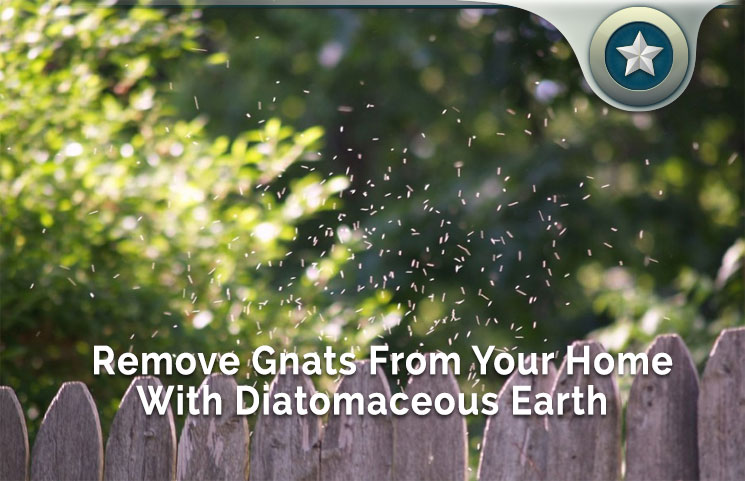Gnats are common flying household pests. A catch-all term that covers all manner of small, flying insects such as midges, small flies and mosquitos, gnats are irritation and unsanitary pests that can be very difficult to get rid of.
There are many different factors that cause a gnat infestation, including but not limited to:
- Decaying or overripe fruit
- Forgotten potatoes or onions
- Potted plants with decaying vegetable matter or unhealthy soil
- Kitchen or laundry leaks that cause standing water
- Unwashed dishes and poor sanitary conditions
- Excessively watered potted indoor plants
Removing gnats from the home once they’ve taken up residence traditionally requires the use of powerful chemicals or aerosol sprays that can have a serious negative effect on the long term health of your family and pets.
Diatomaceous earth provides a natural, organic alternative to these sprays, destroying a gnat menace quickly and efficiently without toxins or poisons. In this article we’ll outline the most common causes of gnat infestation and how to deal with them.
Potted & Indoor Plants
Poorly kept indoor plants are the most common cause of gnat infestation. Many of the potted indoor plants that are purchased from garden stores or groceries are infested with gnat eggs.
These plants contain eggs buried in the soil when purchased, which hatch once the plant has been brought home and watered. The soil that these plants are potted in contains vegetable matter that decays, leading to the development of fungal growth that the larval stage of gnats feed on.
The best way to prevent gnats from entering your home via potted plants is to re-pot the plant before bringing it into your home. After purchasing an indoor plant, remove it from the pot outside of your home and brush away as much of the existing soil as you can from the roots.
Fill a new pot with fresh, healthy soil mixed with a scoop of diatomaceous earth to prevent the development of gnat eggs. It’s possible to use the same pot the plant was purchased in, but be sure to wash it out with warm soapy water during the repotting process.
Overwatering indoor plants also contributes to gnat infestations. Most indoor potted plants require watering only once per week. Watering an indoor potted plant more than this will cause water to build up in the soil, creating an environment that will attract gnats.
Draining your plants regularly and minimizing watering cycles will reduce the amount of gnats in your home. An easy way to tell whether your plants need watering is to insert your index finger into the soil. If the soil is dry up to your first knuckle, your plant probably needs watering.
Diatomaceous earth is an effective tool for preventing gnats from colonizing your potted plants. Lightly dusting both the topsoil and the plant itself regularly will form a protective layer that will destroy any gnats or larvae that attempt to breed in it.
Once a week, after watering your plants, add a fine layer of diatomaceous earth, as well as mixing a small amount into the soil.
Overripe Fruit & Unattended Garbage
Fruit that has been left for long enough to become excessively ripe is another popular breeding ground for household gnats.
Decaying vegetable or fruit matter is a highly attractive source of nutrition for small flying insects, so if you’re experiencing a gnat infestation, throw away all of the fruit in your home.
Any new fruit purchased should be kept in an airtight container in the fridge to prevent further infestation.
Once you’ve placed overripe fruit in the trash, be sure to take it as far away from the house as possible. Unattended trash cans or garbage are the third most prevalent cause of gnat infestation.
An unwashed, full trash can will contain rotting food and vegetable matter that will attract gnats. Be sure to regularly wash your trashcan with warm soapy water and empty it as often as possible.
Dusting the inside of your trash can with diatomaceous earth can be a great way of keeping insect pests away from refuse.
Techniques For Keeping Your Home Gnat-Free
Apple cider vinegar or white vinegar are two highly effective tools for fighting a gnat infestation.
Fill a jar to the halfway point with vinegar and cover the top with plastic wrap, holding it in place with a rubber band. Poke holes in the plastic wrap lid with a toothpick. Gnats will be attracted by the scent of the vinegar and enter the jar via these holes, but will be unable to exit.
Place jars around your home in which you’ve observed gnat activity to trap them.
Diatomaceous Earth Information Guide:
We have a wide variety of food grade diatomaceous earth resources for you look through to make your life a little easier and chemical-free. Please check out the other valuable resources and versatile application uses for silica-rich diatomaceous earth below:
- Diatomaceous Earth Supplementation
- Truth About D.E. Food Grade Silica Supplements
- Diatomaceous Clean Up Tips
- Diatomaceous For Hair Loss
- Diatomaceous Safety Risks
- What Is Diatomaceous Earth?
- Diatomaceous Bed Bug Control
- Diatomaceous Fleas Removal
- Diatomaceous For Chicken Mites
- Diatomaceous Toothpaste Enhancement
- Diatomaceous Environmental Uses
- Diatomaceous Bed Bug Removal
- Diatomaceous Dog Flea Treatment
- Diatomaceous Earth Cleanse
- Diatomaceous Cat Health Benefits
- Diatomaceous Rodent Deterrent
- Diatomaceous Health Safety Risk Warnings
- Diatomaceous Human Health Benefits
- Diatomaceous Cat Flea Treatment
- Diatomaceous Application Tips
- Diatomaceous Beginner's Guide
- Diatomaceous Weight Loss Detox
- Diatomaceous Dog Health Benefits
- Diatomaceous Rapid Roach Removal
- Diatomaceous Earth Ant Removal
- Diatomaceous And Bentonite Clay
- Diatomaceous Earth For Hair, Skin & Nails
- Diatomaceous Organic Exfoliation Skincare
- Diatomaceous Nutritional Smoothie Enhancer
- Diatomaceous Natural Ant Hill Treatment
- Diatomaceous Home Tick Removal Treatment
- Diatomaceous Organic Scorpion Killer
- Diatomaceous Earth, Honey, Coconut Oil Cocktail
- Diatomaceous Earth Safety Precautions
- Natural Diatomaceous Home Spider Removal Treatment
- Diatomaceous For Home Gnats Removal
- How To Use Diatomaceous Earth Powder
- Diatomaceous Natural Flea Removal Treatment
- Diatomaceous Home Bugs & Insects Defense
- Diatomaceous Earth Food Storage Tips
- Where To Find Diatomaceous Earth Online
- Diatomaceous Natural Kitty Litter Odor Control
- What Is Diatomaceous Earth?
- Diatomaceous Organic Fly Repellent
- Diatomaceous Dog Ticks Treatment
- Diatomaceous Carpet Deodorizing Treatment
- Diatomaceous Wasps Hornets Treatment
- Diatomaceous Earth Natural Deodorant
- Diatomaceous Earth Material Safety Data Sheet (MSDS)
- Diatomaceous Home Termite Removal Treatment
- Diatomaceous Natural Aphid Control
- Diatomaceous Natural Cleaning Products
- Diatomaceous Natural Slug Control
- Diatomaceous Organic Feline Tick Control
- Diatomaceous Earth Organic Backyard Tick Control
- Diatomaceous Earth Ant Trail Preventing Tips
- Diatomaceous Chemical Free Home Cleaning Tips
- Best Time Of The Day To Use/Take Food Grade Diatomaceous
- Diatomaceous Gilmour Duster
- Diatomaceous Horse Feed Additive Benefits
- Diatomaceous Earth In Homemade Essential Oil Soaps
- Diatomaceous Earth Home Use Tips
- Diatomaceous Hog Pig Feed Benefits
- Diatomaceous Essential Oil Aromatherapy
- Diatomaceous Chicken & Turkey Feed Additive Benefits
- Silica Supplements Guide
- Silica Mineral Benefits For Hair
- Silica Mineral Benefits For Skincare Health
- Silica Mineral Benefits For Nails
- Silica Mineral Benefits For Teeth & Gum Health
- Silica Water
- Bamboo Extract
- Orthosilicic Acid (Organic Silica)
- Diatomaceous Earth DIY Bath Bombs
- Diatomaceous Earth Squeeze Duster
- Diatomaceous Earth All Purpose Cleaner
- Diatomaceous Earth Drying Flowers
- Diatomaceous Earth Pumpkin Preservation
- Diatomaceous Earth Homemade Body Butter Bars
- Diatomaceous Earth For Cleaning Grease & Oil Spills
- Diatomaceous Earth Bee Care Without Harming
- Diatomaceous Earth Cattle Feed Additive Benefits
- Diatomaceous Earth For Winter Garden Preparation
- Diatomaceous Earth Bed Bug Hotel Traveling Tips
- Diatomaceous Earth For Snakes & Slugs Defense
- Diatomaceous Earth For Polishing Copper Pots & Pans
- Diatomaceous Earth Silverware Tarnishing Protection
- Diatomaceous Earth Elk Feed Additive Benefits
- Diatomaceous Earth Geese Feed Additive Benefits
- Diatomaceous Earth Bison Feed Additive Benefits
- Diatomaceous Earth Sheep Feed Additive Benefits
- Diatomaceous Earth Duck Feed Additive Benefits
- Diatomaceous Earth For Deodorizing Your Shoes
- Diatomaceous Earth For Deodorizing Your Trash Can
- Going Green With Diatomaceous Earth
Please reach out regarding any information above. In the future, more share-worthy useful enhancements, experiences and effects of diatomaceous earth will be added as the benefits continue to pile up. Always welcome for more insight and awareness, click the button to see the most recommended beautifully blended product that combines both high quality food grade diatomaceous earth powder and pure organic silica together in one formula.









